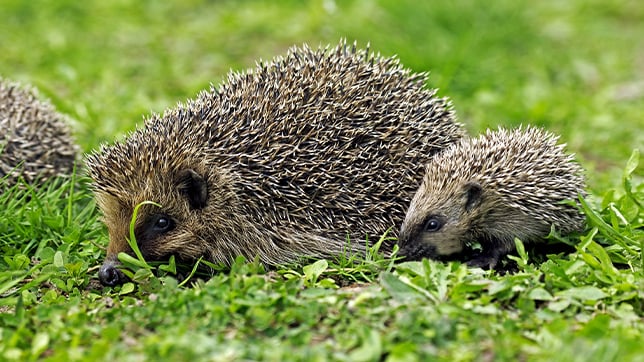1st October 2024
You’ve landed on the next instalment of our fact file series! Through our ‘Tails’ of UK Wildlife campaign, we’re working in partnership with the British Hedgehog Preservation Society (BHPS) to present this fascinating fact file all about the hedgehog.
Let’s explore the wondrous world of the hedgehog…
What are they?
Mammals.
Scientific name: Erinaceus europaeus
Where are they from?
Hedgehogs live in a variety of habitats, from woodland and farmland to parkland and gardens.
However, hedgehogs appear to be doing better in urban and suburban environments, where there’s food, shelter, and opportunity to connect with other hedgehogs (more about this later!).
What's their average life span?
While they usually reach around 2-3 years old in the wild, some hedgehogs have reached 7-10 years of age!
How big are they?
Body length: 15cm-25cm
Tail length: 2cm (Yes, you read that correctly – hedgehogs have tails!)
Leg length: 10cm
Weight: 1.2kg-2kg
Number of spines: 5,000-7,000
Did you know? A hedgehog’s spines protect them and are modified hairs that don’t appear on their face, chest, belly, throat, and legs (which are covered with coarse, grey-brown fur).
What do they eat?
Although they prefer to eat insects, like beetles, earthworms and caterpillars, hedgehogs are omnivores, meaning they can eat other types of food, too.
Important: Hedgehogs are lactose intolerant, meaning dairy upsets their tummies – so, please don’t feed milk to your spiky garden visitors! Instead, make sure you leave shallow dishes of fresh drinking water out for them and keep bowls topped up and clean.
Are they nocturnal?
Yes! Hedgehogs are nocturnal and are known to travel up to 2km each night.
Despite being active through the night, hedgehogs tend to spend most of their daylight hours sleeping and hibernate through the winter months – usually from around November to March – in a sturdy nest made of fallen leaves, twigs, and other vegetation.
Did you know? During the day, hedgehogs will rest in a nest.
Do they mate for life?
No, hedgehogs don’t mate for life. In fact, hedgehogs tend to be solitary, only meeting up during the breeding season (April to September).
Female hedgehogs usually have litters of 3-7 babies, who she’ll nurture for six to eight weeks before they set off on their own. Hedgehogs reach maturity at around 12 months old.
How many are there?
It’s estimated there are fewer than 1 million hedgehogs currently living in the UK.
Reports reveal hedgehog numbers declined between 30%-75% across rural spaces in the UK between 2000 and 2022.
Three fun facts about hedgehogs
Fact 1 – The hedgehog is the UK’s only spiny mammal!
Fact 2 – A baby hedgehog is referred to as a ‘hoglet’ (how cute?!).
Fact 3 – Hedgehogs have a top speed of a whopping 4mph when running in short bursts.

Actions you can take to help hedgehogs
As we mentioned earlier, connecting with other hedgehogs (especially during the breeding season) is essential, so, it’s a big factor in how they decide where to live. Therefore, one of the most significant ways you can support local hedgehogs is to add to your local wildlife network by creating a hedgehog highway.
Other ways to make the world a safer place for hedgehogs:
- Joining BHPS to support their conservation and advocacy work.
- Making sure hedgehogs have enough to eat – by adding log-piles and organic, wild areas to attract tasty insects for them to forage!
- Attracting hedgehogs to your garden in a pet-safe way.
Learn more about The British Hedgehog Preservation Society
The British Hedgehog Preservation Society was founded in 1982 to protect native hedgehogs. Here’s just a snapshot of the incredible work being done by BHPS to care for these beloved spiky mammals:
- Funding research and partnering with other organisations such as the People’s Trust for Endangered Species on key projects, like the National Hedgehog Monitoring Programme, to provide crucial new insights into the conservation and welfare of hedgehogs.
- Developing educational resources to raise awareness of the practical steps we can all take to reverse the decline of hedgehogs in the wild and safeguard their future.
- Offering free First Aid Advice, so anyone who encounters a hedgehog can learn how to help them safely.
Animal welfare blog
If you found this blog useful, why not visit our animal welfare blog to find more articles about animal at risk around the world?
From news and facts, to charities helping protect animals and the great work they do - find out more about animal welfare and those making a difference.
